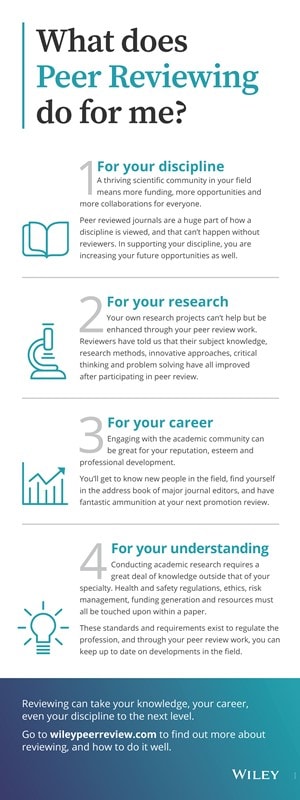The publisher Wiley has produced a bundle of resources about the peer review process – including top tips on how to peer review an article, and what it takes to become a reviewer. Below is an edited excerpt from their website, printed with permission from Wiley.
What is ‘peer review’?
From a publisher’s perspective, peer review functions as a filter for content, directing better quality articles to better quality journals and so creating journal brands.
Peer review functions as a filter for content, directing better quality articles to better quality journals.
Peer review is designed to assess the validity, quality and often the originality of articles for publication. Its ultimate purpose is to maintain the integrity of science by filtering out invalid or poor quality articles.
Running articles through the process of peer review adds value to them. For this reason publishers need to make sure that peer review is robust.
What peer review does best is improve the quality of published papers by motivating authors to submit good quality work – and helping to improve that work through the peer review process.
The peer review system is not without criticism. Even after peer review, some articles still contain inaccuracies and demonstrate that most rejected papers will go on to be published somewhere else. However, these criticisms should be understood within the context of peer review as a human activity.
How can I become a reviewer?
Anyone who is an expert in the article’s research field can become a reviewer. A good reviewer can be at any stage of their career.
All in all, you need enough specialist knowledge to evaluate the manuscript and provide constructive criticism to editors and authors.
There is no one way to become a reviewer, but some common routes include:
- asking a colleague who already reviews for a journal to recommend you
- networking with editors at professional conferences
- becoming a member of a learned society and then networking with other members in your area
- contacting journals directly to enquire if they are seeking new reviewers
- seeking mentorship from senior colleagues
- working for senior researchers who may then delegate peer review duties to you
Top tips for peer reviewers
1. Respond promptly to invitations: When you receive an invitation to review, the article’s abstract will help you decide whether it’s within your area of interest and expertise. Remember to respond promptly or else you might delay the process.
2. Show integrity: Keep the contents of any manuscripts you’re reviewing confidential. You would expect the same of others reviewing your own work. What’s more, if you’ve submitted similar research of your own, or if you’ve reviewed the article for a different journal, let the editor know there’s a conflict of interest. Agreeing to a review for personal gain is not the done thing.
3. Stay within scope: When commenting, make sure your remarks stay within the scope of the paper and don’t veer off subject. If you’re unclear of the scope, editorial policy, presentation and submission requirements, speak to the editor or read the Author Guidelines.
4. Be constructive: Your review should ultimately help the author improve the paper. So make sure you offer some constructive feedback, even if your recommendation ends up being to reject.
5. Allocate enough time: Carefully analysing and commenting on a manuscript can take a good chunk of time. Make sure you have enough time available when taking on a review.
6. Be consistent: Structure your comments by numbering them. It makes the editor’s life a lot easier. You can also divide them into major and minor issues to help authors prioritise corrections. Keep comments to authors separate from the confidential ones to editors. But make sure your comments to authors correspond to your assessment on the confidential review and checklists.
7. Focus on the research: If you’re reviewing a paper that’s in English but wasn’t written by a native speaker, it’s good to be tolerant and point out elements that change the meaning, rather than commenting on the quality of their English.
8. Look at the conclusion first: The conclusion will give you a good idea whether the research is an exciting development within its own field.
9. Check robustness of facts: Editors find it useful if you comment on the number of replicates, controls and statistical analyses. Strong statistics are crucial to determining whether the outcome is robust.
10. Give credit where it’s due: If a paper you’re reviewing is really good and an excellent addition to the existing literature, don’t be afraid to say so.
Content originally published by Wiley, and edited for the Society for the Study of Addiction website by Natalie Davies. The SSA is very grateful for the opportunity from Wiley to share this useful resource with its readership.
The opinions expressed in this post reflect the views of the author(s) and do not necessarily represent the opinions or official positions of the SSA.
The SSA does not endorse or guarantee the accuracy of the information in external sources or links and accepts no responsibility or liability for any consequences arising from the use of such information.

